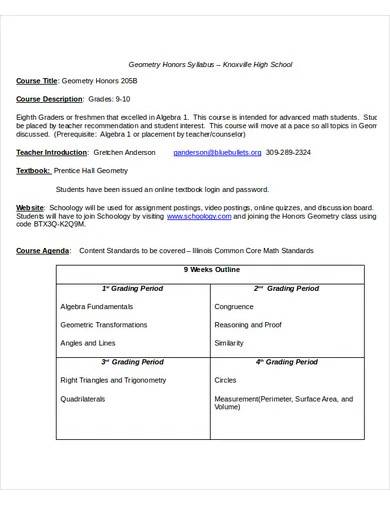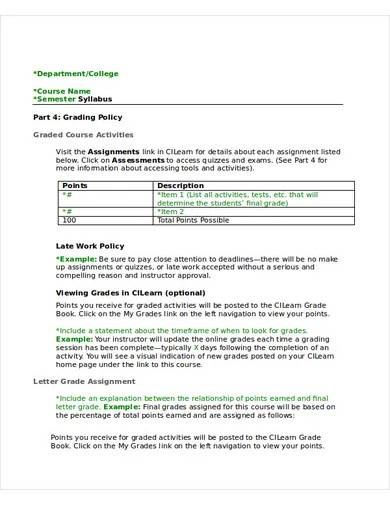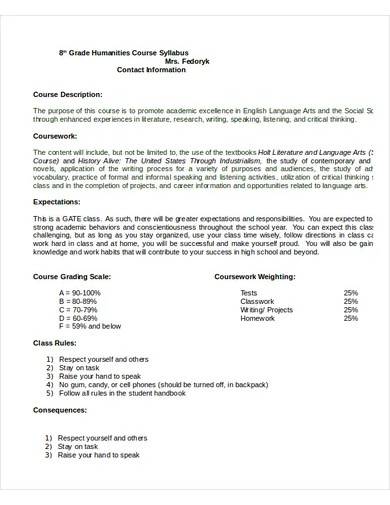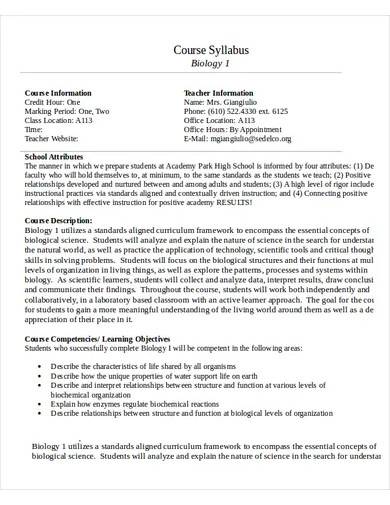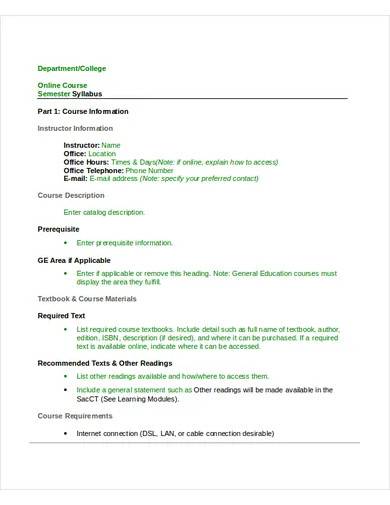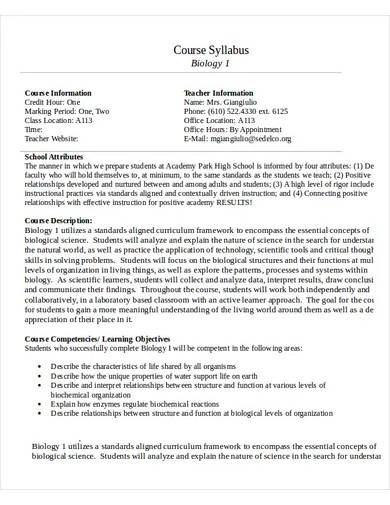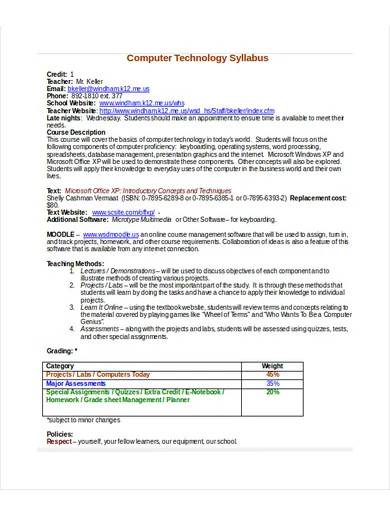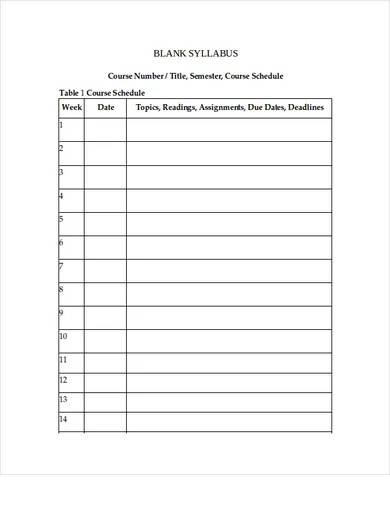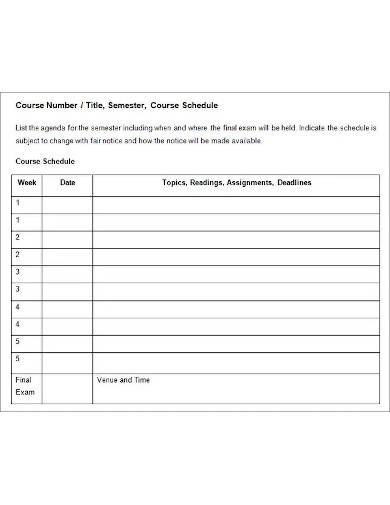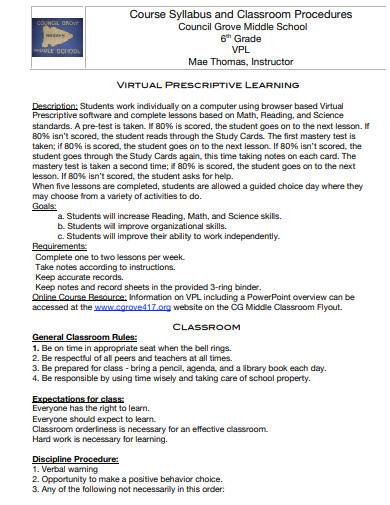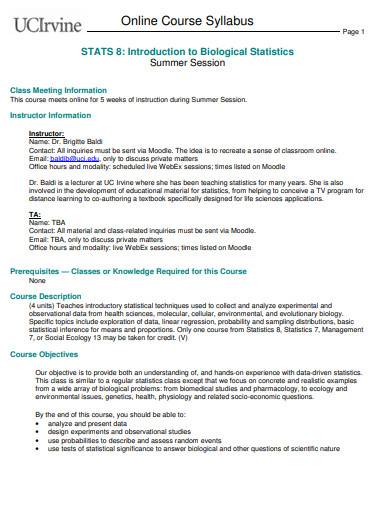A syllabus is a written and printed document that guides students through their courses or classes and gives them an idea of what is expected of them after they accomplish their course. It contains essential information that matches an all-inclusive curriculum which provides a general description of a class. A curriculum outline and a syllabus template define all the topics a professor is planning to teach, the resources they’ll use, and the individual lessons that will support every topic.
FREE 10+ Class Syllabus Samples & Templates
1. High School Syllabus Template
2. Educational Course Syllabus Template
3. Sample Middle School Syllabus
4. Sample Teacher Education Syllabus
5. Online Course Semester Syllabus
6. Biology Course Syllabus Template
7. Sample Computer Technology Syllabus
8. Printable Blank Syllabus Template
9. Sample Course Syllabus Template
10. Course Syllabus and Classroom Procedures
11. Sample Online Course Syllabus
What is a Class Syllabus?
A class syllabus or also called a course syllabus is a document used in academies and other forms of educational institutions to relay information about a particular class or course and explains the responsibilities, rules, and expectations that come with it. With a syllabus template, schools and universities can create a writing outline of all the important information about each of the college courses it offers.
How to Create a Class Syllabus
As a part of a professor’s passion and strategic planning, a class syllabus provides students with a detailed description of the class’s or course’s goals and objectives, assessment techniques, and learning outcomes. With a class syllabus, students can create an effective academic career plan and use a daily schedule planner, homework planner, student planner, and more. The development process of a syllabus differs from each institution’s standards and resources but all of them aim to communicate all important aspects of a class or course to the students.
Step 1: Provide the Class’s Name and Basic Course Information
Include the class name and course code in the syllabus’s title to give the reader an idea of what to see. Basic course information refers to the information relevant to the class or course’s cataloging, tracking, and outcomes. this information includes the credit hours, format, prerequisites, and a brief description.
Step 2: Determine the Course Goal
Goal setting will help the students determine that they have successfully accomplished their learning objectives. Effective goals are short statements that tell what to expect from the students to know by the end of the class or course. Provide details about the course’s teacher or mentor, a list of materials needed, and a class calendar schedule for the students’ and administrators’ reference.
Step 3: Mention Policies that Differ From the School Policies
Mention any policy and procedure that differ from the school policy. This policy includes an attendance policy that the students must follow during hands-on activities. Make sure to document this policy and share it with the students.
Step 4: Review the Syllabus
Reviewing the syllabus can be done in two ways which can be by self-reviewing or peer reviewing. Some professors utilize self-review because they have the authority over which subject or topic to teach while some use peer review when they need to ask a colleague to review their syllabus.
FAQs
What are the basic parts of a syllabus?
The four basic parts of a syllabus are the instructor’s information, reading materials and supplies, policies, and class schedule.
What factors does a syllabus cover?
A class or course syllabus provides information about due dates or deadlines for certain tasks, key preparation for class, assignments, how a student will be graded, time management, organization tips, and the preferred ways to communicate with the professors and other classmates.
How does a syllabus benefit a student?
With a syllabus, students are given an idea of what is expected of them during the entire duration of the class or course. They will be able to know the topics the class will be covering, what assignments to complete, when will assessments be performed, and more.
A class syllabus is one of the important documents needed in teaching as it provides an outline of the basic components of a class or course such as the topics to be discussed, a weekly schedule, a list of exams, assignments, and other associated tasks related to the course. It can also establish connections between the learning outcomes, assessments, content, and other educational practices which guide the students throughout their learning activities and journey.
Related Posts
FREE 9+ Sample High School Lesson Plan Templates in PDF MS ...
FREE 8+ Weekly Lesson Plan Samples in Google Docs MS Word ...
FREE 7+ Sample Music Lesson Plan Templates in PDF PSD
FREE 8+ Feature Writing Samples in PDF DOC
FREE 9+ Sample Lesson Plan Templates in MS Word PDF
FREE 4+ Sample Course Evaluation Templates in PDF
FREE 9+ Sample Students Feedback Forms in PDF MS Word
FREE 7+ Sample Unit Lesson Plan Templates in PDF MS Word
FREE 7+ Sample Weekly Lesson Plan Templates in Google Docs ...
FREE 9+ Sample Curriculum Planning Templates in PDF MS Word
FREE 8+ Sample Elementary Lesson Plan Templates in PDF
FREE 6+ Sample Lesson Plan Templates in PDF MS Word
FREE 9+ Classroom Management Strategy Samples in PDF DOC
FREE 7+ Sample Middle School Lesson Plan Templates in PDF ...
FREE 8+ Sample Substitute Teacher Job Description Templates in ...

